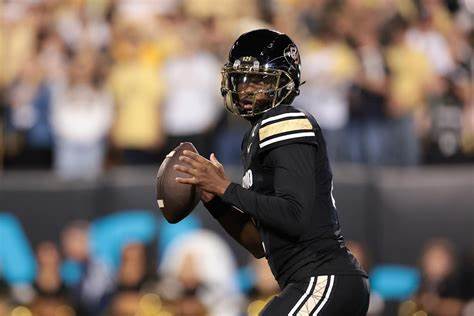 April 10, 2025 - BY Admin
April 10, 2025 - BY Admin
Like all well-informed and nuanced conversations, the debate took off in earnest on social media.
Is there reason for concern over Shedeur Sanders’ throwing motion?
A media member tweeted a video of Sanders throwing at Colorado pro day. The commentary presented: “Lots of double-taps and hitches from Shedeur today, NFL defenders close windows quickly, this was a concerning workout.”
Then NFL players began to chime in.
New York Giants wide receiver Darius Slayton argued that Sanders could “pat the ball and be just fine” because “if DB’s [sic] was so good at breaking on ball pats they’d all have 8+ picks a year.”
Jacksonville Jaguars safety Andre Cisco accused Slayton of “tryna secure some future targets,” while Cowboys edge rusher Micah Parsons questioned: “You realize [a] Pat on the ball can be difference between a sack or a throw away/ completion?”
Slayton was ready with a response.
“Tom Brady literally the king of getting the ball out fast when he threw. So actually no patting the ball is not the difference.”
The conversation between players sheds a light on how they study opponent film and game plans, respectively. It also raises a question about the quarterback scouting process and ultra-detailed analyses that teams project onto a famously inexact science.
Some talent evaluators will say every detail is relevant to consider. But on the scale of relevance, where do teams consider patting the ball to be?
Yahoo Sports asked two former NFL offensive coordinators, one former NFL defensive coordinator and three talent evaluators for their perspectives.
Their main takeaway: The question at hand isn’t really about whether Sanders is patting the ball.
To pat or not to pat, that may not be the question
Parsons’ initial question was sharp, one former AFC offensive coordinator.
Coaches and talent evaluators say they are less concerned about a quarterback potentially tipping off a defender than they are about the increased risk as a quarterback continues to hold the ball.
“The pat doesn’t really bother me because his mechanics are clean and he gets it out quickly,” one NFC evaluator said.
Added a former NFC offensive coordinator: “As long as the release is quick it’s a non issue.”
The crux of the question is instead: Does Sanders, or any quarterback who pats, get the ball out with the timing and rhythm the scheme and play-caller require? If the pat is in rhythm and the release is quick, as multiple sources believe is true of Sanders, the motion need not hurt his mechanics.
In four years across Jackson State and Colorado, Sanders completed 70.1% of his passes for 14,327 passing yards, 134 touchdowns and 27 interceptions.
His last season was his most accurate and most productive, Sanders completing 74% of his 477 attempts for 4,134 yards, 37 touchdowns and 10 interceptions.
Slayton’s invocation of Brady may have been extreme, but there’s a strong belief across the league that patting is common in many of the league’s best throwers, past and present. The pat alone is not an issue offensive coaches need to prioritize nor a tell that defensive coordinators typically emphasize, they say.
“It’s normal lol,” one AFC talent evaluator said.
An NFC talent evaluator said the pat concerns them less than a wind-up, because defensive backs “are taught to break when the ball fully disconnects from the hand.”
Only one of the six league sources polled was concerned about Sanders’ patting, and that was because of its frequency.
“It’s more important to know how consistently QBs do it,” the evaluator said. “Some do it way more consistently than others and that’s when it’s an issue/tell.”
Where did the evaluator believe Sanders lands on the spectrum of patting volume?
“It’s almost every throw,” the evaluator said, “so definite tell.”
For Shedeur Sanders and all QBs, weighing tells takes context
A former NFC defensive coordinator was somewhat amused by the conversation that traveled far even by draft buzz standards.
“Now obviously it’s out there and it’s on social media, so everybody’s going to make a big deal over it,” the coordinator said. “If the guy can throw the ball on time and in rhythm, and read coverages all right, the guy will be all right.”
The top reason: Tells, or advance hints, abound in NFL scouting. Even if Sanders’ pats reveal a trend of his passes, defenders are unlikely to have the bandwidth and vision to capitalize on those tells often enough in real time to make a difference.
Sometimes a quarterback pat will be obscured by an offensive lineman’s protection; other times, quarterbacks mix in decoy pats to keep defenders honest.
A deep safety may have a “half-second tick” head start in certain coverages, the former DC said. But a pat in the normal rhythm of a throwing motion isn’t the same as a pat to buy time diagnosing disguised coverages.
The former coordinator said they’d be cautious before guiding a player to react immediately based off a pat. The coordinator would want a player to already have demonstrated evidence both that he could handle more detailed scouting reports and make positive plays accordingly.
“I’d say probably three, four times in my career, I’ve said, ‘Hey, if we’re in this coverage, if you got this thing and you see this thing, just go,’” the coordinator said. “But I’ve done that … regardless of [if the quarterback] pat the ball.”
A pat can be a tendency. But it’s a common one, one among many, and not often one on which a defense can capitalize — especially if the release is still quick.
“It’s not one that you’re scouting like, ‘Oh man, I got a big one this week, this guy pats the ball,’” the coordinator said. “It’s never been like that.”